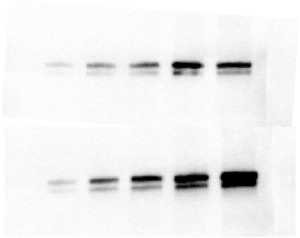
When did you last change your foam inserts in the blotting apparatus, the blotting sponge pads? The answer is probably “never”. Because if the transfer works, why bother? I worked in several labs and in all of them, we hardly ever changed the pads, only when they’ve become grey and lumpy, once in a couple of years.
But Advansta technical specialist, Kimberly Schwartz, who has 17 years of Western blotting experience, is passionate (and I don’t use this word lightly) about the necessity of changing blotting pads regularly. We asked her to explain why.
Why do you think changing the pads is important?
A common source of transfer problems is the tightness of the sandwich. A good sandwich must be tight! Make sure yours is too, by replacing your transfer sponge pads regularly. Using extra sheets of filter paper to compensate for worn-out sponges may cause inconsistencies with your transfer.
We all change our kitchen sponges regularly because they pick up contaminants, transfer sponge pads also become contaminated over time. Using clean sponge pads is especially critical for fluorescent applications as many of these contaminants can auto-fluoresce resulting in high background.
How often do you recommend changing the pads?
The frequency of replacement depends on how often you perform western blots. If you work in a busy lab with lots of Western blotters, it is a good idea to change the pads once a month. Advansta sponge pads are white so that contaminants can be easily seen. If the pads appear to be discolored or compressed, it is time to replace them.
What are the tell-tale signs that your pads need changing?
If nothing else has changed in your experiment but your results are just not what you expect, the sponge pads may be the culprit. Worn out sponge pads can result in inconsistent transfer, decreased signal and the unfortunate disappearing act of your proteins.
Thank you.
If Kimberly’s words don’t persuade you to change your pads now, I hope her pictures, used in this post, will. Our headliner image is a Fluorescent Western Blot using an old and dirty set of sponge pads. Contaminants deposited on the membrane fluoresce in the Cy3 channel.

Titration of lysate transferred with old compressed sponge pads on top and new sponge pads on the bottom.

An example of disappearing proteins from a transfer stack that was not tight. Because of the high transfer efficiency of FlashBlot some of the proteins that were “running away” were still captured on the membrane.

Leave a Reply